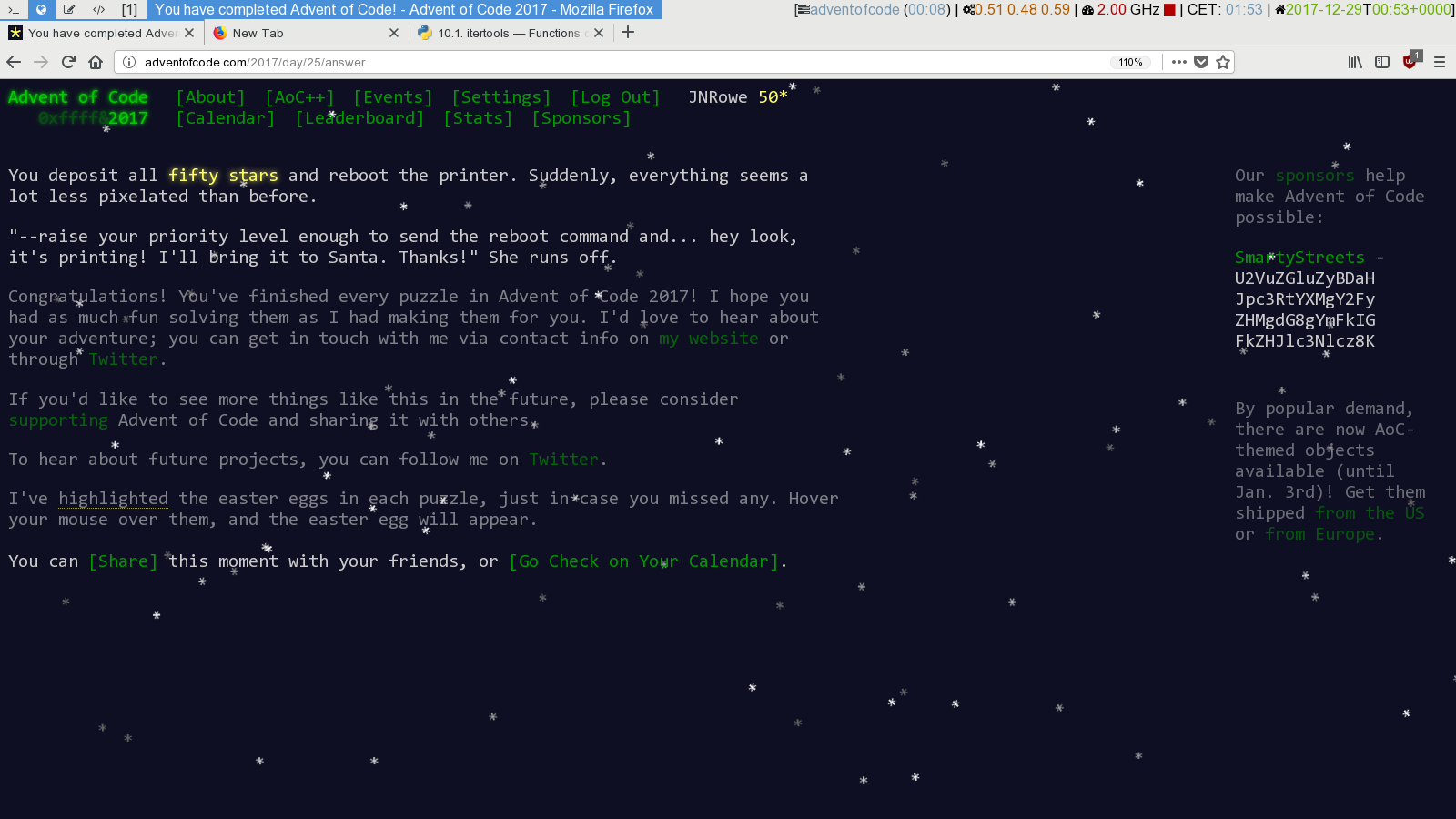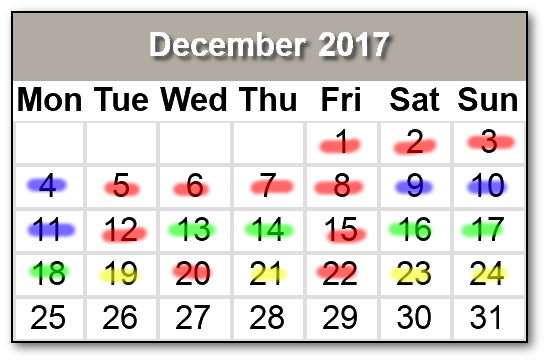Estimated reading time: 7 minutes
Advent of Code 2017¶
A very evil friend pointed me to Advent of Code last December, and I burnt a fair chunk of time on it. I mean… yeah, it was hugely fun but be warned it is enormously addictive1.
Important
I must say that I meant to write this last December, but things got in the way and writing doesn’t earn me enough valuable Internet points. Don’t take this being 10 months late as a knock against AoC, but more as me thinking we’re on the cusp of a one month countdown to it beginning again(hopefully).
Why?¶
This answer should be obvious; puzzles are fun, competitive ones where you prove yourself against co-workers and total strangers even more so. If that isn’t enough reason to have a go, then I simply don’t want to know you.
Lessons¶
It is huge fun, but if you want to get on the leaderboards you must be up when the puzzle is released. Sadly, in the UK that means waking up for a five in the morning start.
If you look at my completion screenshot, you’ll also see I have the
itertools documentation open. If you’re going to use Python for AoC
study up on itertools, it will help no end2.

The other thing you can see in my screenshot is that I didn’t complete the event on Christmas Day, in fact I took a break and finally mashed through the final week on the evening of the 28th. Infinite time, unemployment or being smarter would be a great help here.
Approach¶
With the exception of one day — where the answer just jumped out at me — I used exactly the same approach. Whack out a solution for the given samples that tested green, then chuck in my magic string to get a hopefully correct answer to submit. Once successful I’d return to the code to clean it up, and also to think through the problems a bit more. As with many things in life, there can be a lot to learn through posthockery.
If we look at the description for day 1:
The captcha requires you to review a sequence of digits (your puzzle input) and find the sum of all digits that match the next digit in the list. The list is circular, so the digit after the last digit is the first digit in the list.
For example:
1122 produces a sum of 3 ( 1 + 2) because the first digit ( 1) matches the second digit and the third digit (2) matches the fourth digit.
1111 produces 4 because each digit (all 1) matches the next.
1234 produces 0 because no digit matches the next.
91212129 produces 9 because the only digit that matches the next one is the last digit, 9.
I immediately dumped the samples in to a Python doctest file as:
"""
>>> captcha('1122')
3
>>> captcha('1111')
4
>>> captcha('1234')
0
>>> captcha('91212129')
9
"""
Now we’ll know we’re on the right track when python3 -m doctest day01.py
stops spitting out errors. Looking at my git repository it looks like my first
dirty solution was:
@str_to_ints
def captcha(ints):
total = 0
for n, last in zip(ints, [ints[-1], ] + ints[:-1]):
if n == last:
total += n
return total
You’ll notice I’ve slapped a decorator on the function, with the assumption that I’ll want to convert an iterable to integers again before the month is out(I was right). Its implementation was a rather basic:
def str_to_ints(fn):
def wrapper(s):
ints = [int(c) for c in s]
return fn(ints)
return wrapper
Eagle-eyed Pythonistas will spot the horrific error here, I forgot that
decorators will wipe out my docstring and the doctest runner won’t pick
up my captcha tests at all. The solution is to reach for
functools.wraps() and a tiny edit:
--- a
+++ b
@@ -1,2 +1,3 @@
def str_to_ints(fn):
+ @wraps(fn)
def wrapper(s):
I know full well that this is a better solution than diving in to the REPL for me. I tend toward code golfing myself in a REPL, so I’d end up with something more like this:
>>> i1, i2 = tee(map(int, '91212129'), 2)
>>> sum(x for x, y in zip(i1, islice(cycle(i2), 1, None)) if x == y)
I wish I could say this was made up to prove a point, but that is a chunk from my ptpython history when I was playing around trying to think of a “cleaner” solution after getting the correct answer3.
I followed the same basic pattern for each puzzle, always using the same file for part one and part two of the puzzles. Occasionally needing to refine my part one solution for an edge case that part two exposed. I’ll spare you the blow-by-blow of the other 24 days, as frankly the code is the least interesting part of the puzzles in my opinion.
Implementation¶

Language frequency for AoC puzzles¶
I used Python for over half the days, PyPY for a few where my immediate thought was to reach for brute forcing a solution with a naïve algorithm, lua via luaprompt on one day where it was clear all I really needed was a calculator, and nim on five days where I was using my Winterval break to learn nim.
Results¶
I only made it on to the leaderboard once, and I was excited.
Got myself on the #aoc leaderboard this morning(#91)… now back to sleep as its 5am 😴 http://adventofcode.com/2017/leaderboard/day/9
I like to think I could have done better if it didn’t require getting up at five in the morning to compete, but that is the just the lie I’m telling myself to feel better.
All told, I spent nine hours on AoC and those hours were spread pretty evenly between the “live” 2017 puzzles and the previous years. I’m up for calling it personal development, and I’m hoping it returns this year!
Tips¶
Honestly, I’m going to push against the grain on this. All my co-workers who have commented on this have said AoC is a great way to learn a new language, but I massively disagree. Even if you ignore the leaderboard, you’re only making tiny little one-off programs without the need for any real design. Granted you can learn some of the basics quite well, but it feels closer to doing a few “hello world” implementations. The puzzles themselves are more in depth than “Hello world” for sure, but the implementations aren’t likely to be very interesting or didactically useful.
Read the problems and think first, obvious I know… but when the stopwatch
is running it is easy to jump to the editor. For example, day 12 is clearly
pretty easy to solve by reaching for new code, but even easier to solve with
graphviz. In this specific instance you can use sed to fiddle the input,
ccomps to filter the input for the 0 node, and finally use gc to
count the nodes4. I’ll admit here the code I used to submit my answer was
all new, and I didn’t use graphviz until I thought about how to refactor my
20 lines of Python. I did use graphviz to solve day 24’s puzzle, so
even I can learn from my own advice on occasion.
I used moonscript for day 21, which was a mistake because the syntax wasn’t a good fit. It would have been faster, shorter and cleaner to use Haskell, as I did when I reworked it after submitting. Really, this is the same point as the last but should be repeated: think first, appropriate tools matter.
If you’re going for the leaderboard you need to be really fast, so: Use fast languages, be all over your chosen weapon’s standard library, and use your editor’s snippets well. Every. Second. Counts.
And finally, keep your old solutions around either in files or in your REPL’s history as you might end up revisiting them, as was the case with day 14 for example.
Hopes for 2018?¶
Number one? That it returns. It was a great deal of fun. It spawned a fair amount of interesting water cooler chat too.
Number two? That the options to pay for it are better this year. Last year I had a friend tip some money towards the AOC++ scheme in my place, as the available options wouldn’t work for me at all.
If I had a number three it would be to figure out a way to make it work without having to get up at five, I just can’t even imagine what that could be.
Footnotes
- 1
More so as the puzzles from previous years are still online, so you can end up sucked in to old puzzles very easily.
- 2
Frankly, I’m of the strong opinion that you should be studying up on
itertoolsall the time anyway. It just that other Python developers aren’t always familiar enough with the module for use in large shared code bases, so help to make this a reality!- 3
For some value of “cleaner” which is both unique to me and a totally untrue.
- 4
In fact, this tip isn’t specific to AoC at all. Just stop reading now and learn to use graphviz, it can be used to solve so many engineering problems.
Authenticate this page by pasting this signature into Keybase.
Have a suggestion or see a typo? Edit this page
